| IMPORTANT: City staff are pleased to announce that an aerial spray program will not be necessary in 2022 |
The spongy moth – formerly known as the Lymantria dispar dispar (LDD), European or Asian gypsy moth – is a defoliating insect found in Ontario. At the caterpillar stage, it feeds on leaves from hardwood trees such as oak, maple, birch and poplar. Like all forest pests, their populations are cyclical and peak in intervals. Southern Ontario is currently experiencing a peak point in the spongy moth population cycle.
Spongy moths have natural enemies that aid in reducing the population in highly infested areas. These include soil-borne bacteria, squirrels, chipmunks, raccoons, skunks, more than 15 species of birds and several native insects. The manual removal and destruction of egg masses also drastically reduces the presence of caterpillars the following season.
City staff have undertaken control measures in known moth hot-spot areas to reduce the spongy moth population. Residents can also help reduce the spongy moth population by taking precautions to protect trees on their property. Please refer to the Home Control Methods below for further information.
Spongy Moth Monitoring Program
Have you seen trees with pink dots and bands tied around them? These flagged trees are very important, we ask that park users do not remove the flagging or dots as these trees are monitored to track the emergence and activity of the egg hatching and leaf development to determine if spraying is necessary and if so, the most effective time to complete the aerial spray program.
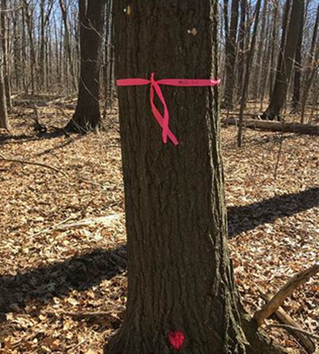
Home Control Methods
To help protect trees on your property from these invasive insects, the following precautions can be taken throughout the year:

| January to April | Scrape and Destroy Egg Masses Scrape off and destroy egg masses by submerging them in a bucket of water and soap for at least two days. After that time, discard of the solution and egg mixture. Doing this will help prevent more caterpillars from hatching in the future. It is important to look thoroughly on your property for egg masses as they can also be found on benches, firewood, outdoor furniture, swing sets and under the eaves of buildings. |
| April to June | Apply Biological Control Products Applying biological control products to affected trees early in the season can also reduce infestations. Contact a licensed tree care company to discuss options for applying biological control products. There is a very tight timing window for some products. |
| May to August | Install Burlap Bands Trap caterpillars by wrapping burlap around tree trunks to make it easier to collect them. Check your burlap band daily, remove trapped caterpillars and place them in a bucket of soapy water for a day or two before disposing. |
| June to July | Handpick Caterpillars Remove caterpillars by hand and place in a bucket of soapy water for a day or two. |
| August to December | Scrape and Destroy Egg Masses Scrape egg masses off trees and place in a bucket of soapy water for a day or two. |
Ensure you always wear gloves when handling caterpillars and egg masses to avoid an allergic reaction.
Note: If you have concerns about a tree on your property, contact a certified arborist. For materials and supplies to help control the population, contact your local nursery or garden supply store. To help promote new leaf growth, water the trees that have been affected by spongy moths.
Spraying for 2022
Based on the inventory completed by Lallemand Inc./Bio-Forest over the winter of 2021/2022, large numbers of new egg masses were not found anywhere in the survey area, and therefore city staff are pleased to announce that an aerial spray program be will not be necessary in 2022.
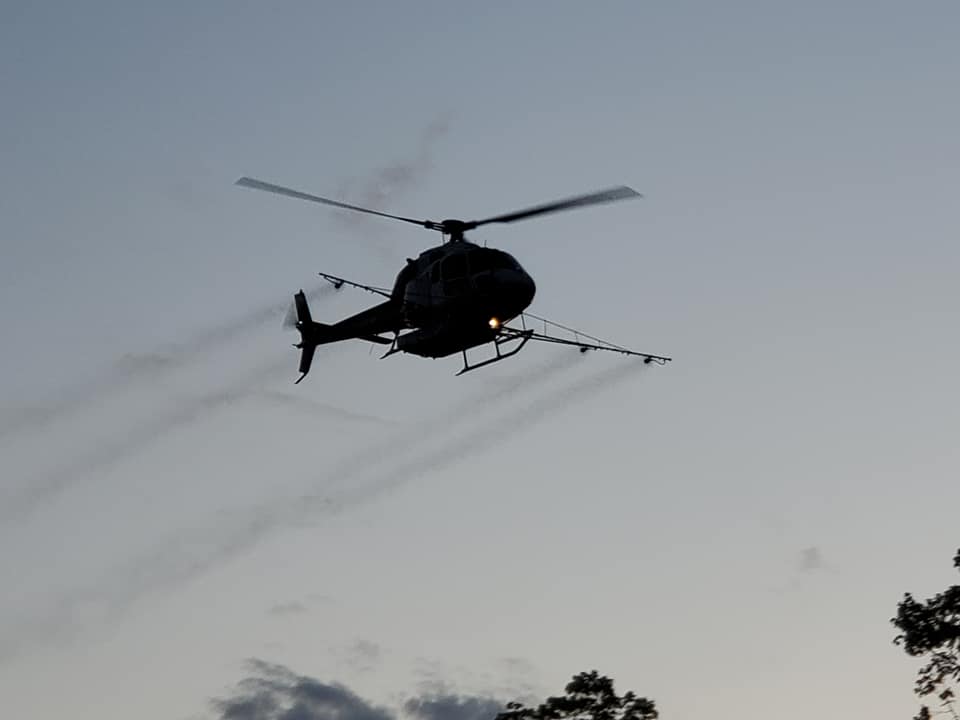
Past Spraying Information
Based on the inventory completed by Lallemand Inc./Bio-Forest over the 2020/2021 winter, staff recommended that an aerial spray program be advanced in 2021 for the areas on both public and private property identified as having potentially ‘severe’ infestations, as well as additional areas on public lands that were identified as having ‘moderate to severe’ infestations.
On April 19, 2021, Sarnia City Council approved the recommendation for Spongy Moth (formerly Gypsy Moth) Spray treatment in Sarnia for 2021.
The aerial spray program was carried out by helicopter; applying the biological pesticide Foray 48B Biological Insecticide Aqueous Suspension, active ingredient is Bacillus thuringiensis subspecies kurstaki (Btk), Registration No. 24977 under the Government of Canada’s Pest Control Products Act (S.C. 2002 c. 28).
Lambton Public Health – Use of Baccillus thuringiensis subspecies kurstaki pesticide (Btk) for Control of Gypsy moths in Lambton County
About Spongy Months
Why is it called the “spongy” moth?
The spongy moth is formerly known as the Lymantria dispar dispar (LDD), European or Asian gypsy moth. This new common name was selected by a working group of 50 scientists and professionals from Canada and the United States following an extensive public consultation process. “Spongy moth” acknowledges the conspicuous, spongy egg masses that the insect produces. In line with other organizations, the City of Sarnia has adopted “spongy moth” and will be using this term moving forward.
What do spongy moths look like?
As egg masses, they are fuzzy, oval and light brown. As caterpillars, they are dark-coloured, hairy and have a double row of blue and red spots down their backs. As moths, males are light brown in colour and females are white and do not have the ability to fly.
Where did spongy moths come from?
Spongy moths originated in Europe. They were first detected in Ontario in 1969.
Why are spongy moths a problem?
While spongy moths are not harmful to humans, they can cause severe defoliation. Most healthy trees will survive several years of defoliation, but unhealthy trees have less reserves to regrow a second crop of leaves and will be less resilient to repeated defoliation.
What is the lifecycle of a spongy moth?
Spongy moths have four life stages:
- egg mass (August to May)
- caterpillar (May to July)
- pupa (June to July)
- moth (July to August)
Egg masses remain in place all winter and hatch the following spring from late April to mid-May. Once hatched, the caterpillars begin to feed for approximately seven weeks. The pupae are formed once the larvae have matured. They then transition to the moth stage, which is short-lived and seen in mid-summer. Both sexes then die after the female lays its eggs on the limbs and trunks of trees, on rocks, buildings or in other sheltered areas.
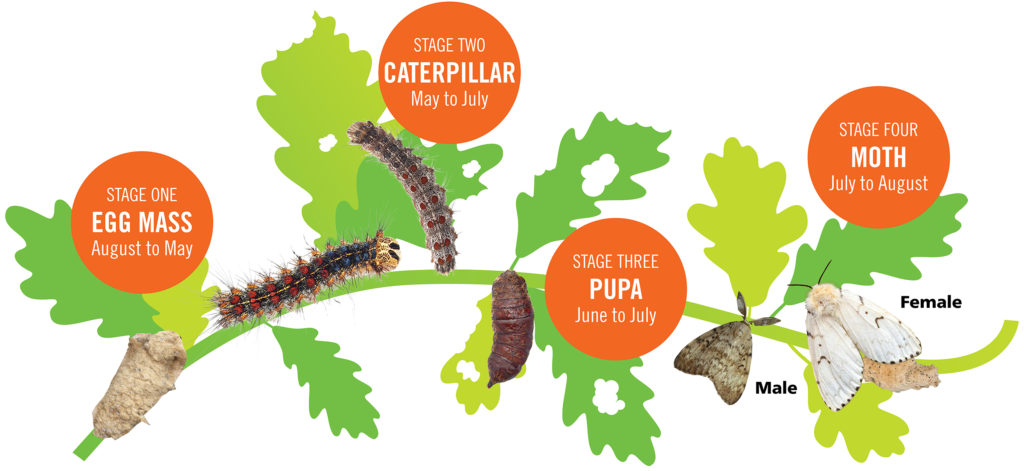
Stage 1: Egg Mass
- Tan-coloured and can be found on tree trunk and bark crevices as well as other hard surfaces such as outdoor furniture, decks and firewood piles.
- The insect spends the winter in the egg stage, hatching the following spring.
- One egg mass can contain 100-1,000 eggs.
- Egg masses can be between 2-6cm in size
- Spongy egg masses can be observed on the trunks and branches of infected trees.

Stage 2: Caterpillar
- Greyish brown and hairy.
- Caterpillars hatch from eggs in the spring (end of April/early May) and the emerging caterpillars climb up the tree to feed on the leaves.
- During the early stage of growth, caterpillars are small and black.
- Fully grown caterpillars have five pairs of blue dots and six pairs of red dots that run down its back.
- Mature caterpillars can grow up to 6 centimetres in length.
- Caterpillars can be found feeding on the leaves of trees causing defoliation and damage.
- The caterpillar stage lasts approximately 40 days.

Stage 3: Pupa
- At the end of the caterpillar stage, the larvae seek shelter to pupate. In the early summer, larvae enter a transitional stage for 10-14 days in which the larvae transform into adult moths.
- Once the adult emerges from the cocoon it leaves the empty cocoon behind which is often seen on infested trees.
- Dark brown, shiny shell with hairs sticking out of the shell.
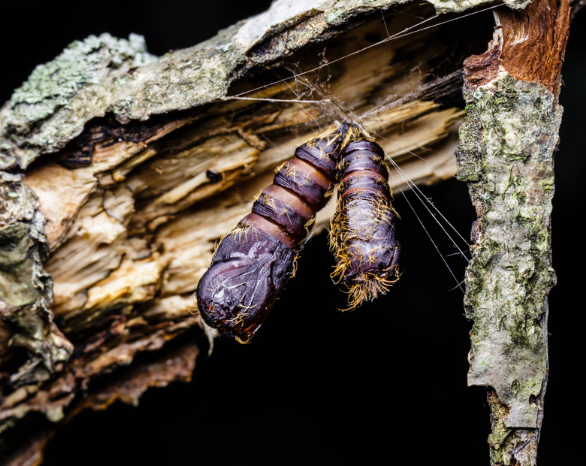
Stage 4: Moth
- The LDD/Spongy Moth has less than two weeks to mate and reproduce before they die.
- Female moths can lay between 500 to 1000 eggs.
- Male moths fly, female moths do not fly.
- Female moths often remain on the tree they fed and pupated on.
- Adult females are larger than males with white colouring.
- Adult males are smaller and greyish- brown.
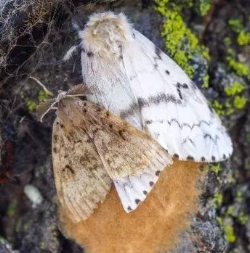
For more information on spongy moths, visit the Entomological Society of Canada (ESC), the Government of Canada, or the Government of Ontario.